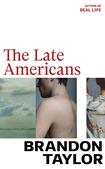
US novelist Brandon Taylor made his literary debut in 2020 with Real Life, a powerful campus novel that made the Booker Prize shortlist. It was a masterclass in contemporary writing, with an unforgettable protagonist, crafted in a traditional style. An acclaimed short story collection, Filthy Animals, followed in 2021.
The Last Americans, in form, feels more related to the latter collection of linked narratives. Once again, Taylor has applied his skill for forensic examination to a campus community – this time a Midwestern college for artistic disciplines that closely resembles the famous Iowa Writers’ Workshop where Taylor studied. Whereas, however, Real Life offered the reader an immersive experience deep into the psyche of one character – comparisons were drawn to Virginia Woolf’s Mrs Dalloway – each extended chapter in this second novel is told from a different character’s perspective. In storytelling terms, they are linked mostly by place, interconnected in minor ways, sometimes making a brief cameo in each other’s stories. Thematically, however, they are plagued with many of the same existential questions, bouts of ennui and anxious ambition, external and self-imposed pressures. Most are aspiring artists – a poet, dancers, musicians – pursuing art to different degrees that is both a means of, and threat to, their survival.
Occasionally the gaze is extended beyond the students to include those working in the margins of campus life, examining the intersection between the two communities. Taylor is excellent at scrutinising societal malaise, class and financial inequity and crystallising the toxic relationship between commerce and art. He is adept at illuminating with grace how political the personal actually is, with an unflinching determination to find the truth, however ugly or beautiful.
The novel suggests a deep understanding of human nature and the corporeal reality of physical bodies sometimes existing in harmony, sometimes at war with interior selves. Whether the characters are having sex, debating discourse, or making rent, he deftly gets under their skin.
Excuse My French restaurant review: An experience simply unlike anything else in Dublin
Ireland’s remote islands: Only 29 apply for €84,000 grant aimed at attracting residents
10 of the best new shows to watch in April: including Netflix medical drama and two AppleTV+ releases
MobLand review: Pierce Brosnan’s Irish accent is a horror for the ages. Forget licence to kill, this is more Darby O’Gill
Taylor’s authorial voice is strong, and the grand design of his novel is carefully orchestrated. At times, however, the diversity of his characterisation is weakened by the similarity of tone throughout and this makes it increasingly hard to distinguish between all the players. Nonetheless, there is an embarrassment of riches here in terms of zeitgeist deconstruction, identity construction and the mobilisation of artistic impulse. Taylor asks who gets to make art, and why. And he isn’t afraid to tell us the answer.













